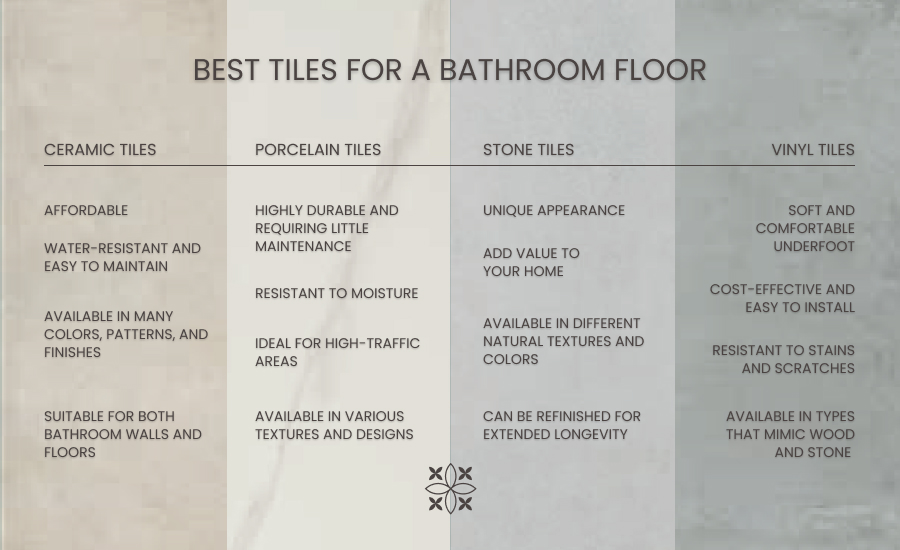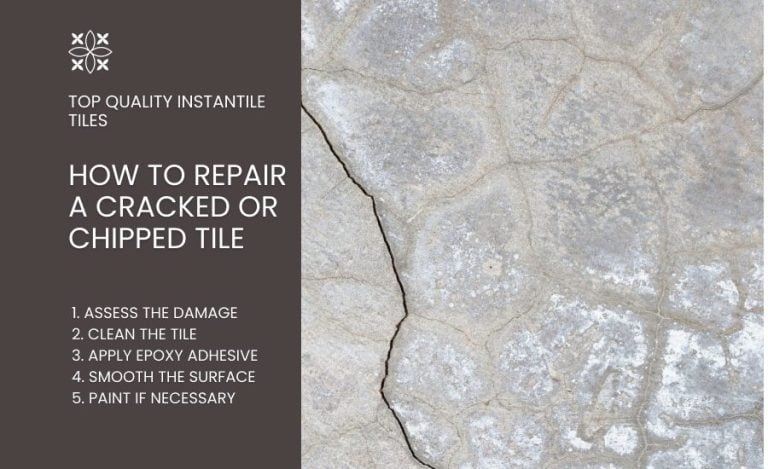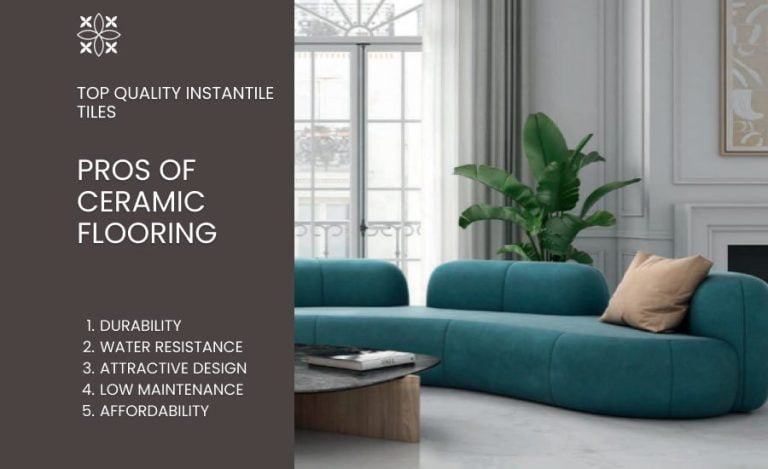Best Tiles for a Bathroom Floor: Key Takeaways
- Different tile materials offer durability, water resistance, maintenance efforts, and style that can affect your choice when looking for bathroom flooring
- Additional features to consider are tile finishes and textures, which can improve slip-resistance and support safety
- Interlocking tile systems reduce installation time and simplify repairs
Imagine waking up in the morning and nearly slipping on your tiled bathroom floor, only to notice the cracks and outdated design that’s been irking you for months. Solution? It’s time for new tiles.
But what are your best options?
This guide will break down:
- What are the best tiles for bathroom floors
- How finishes and textures affect appearance and safety
- How to choose tiles for your bathroom floor
Best Tiles for a Bathroom Floor
The market offers various bathroom tiles, and you may find yourself confused about what to go for. Here’s a breakdown of the top choices and what makes them great.
Ceramic Tiles
Ceramic tiles are made from natural clay that is mixed with water and other minerals, molded into tile shapes, dried, and fired in a kiln at high temperatures.
You’ll often find them glazed for durability, though unglazed versions offer a rustic charm if that’s your style.
Pros of ceramic tiles:
- Affordable
- Water-resistant and easy to maintain
- Available in many colors, patterns, and finishes
Suitable for both bathroom walls and floors
Porcelain Tiles
Porcelain tiles start with a refined clay mix that includes kaolin, silica, and feldspar. They’re fired at intense heat, resulting in dense, durable tiles that won’t easily absorb water.
Pros of porcelain tiles:
- Highly durable and requiring little maintenance
- Resistant to moisture
- Ideal for high-traffic areas
- Available in various textures and designs
Stone Tiles
Cut from slabs of stone such as marble, granite, slate, and travertine, natural stone tiles are then processed to get different textures and finishes, such as polished, honed, tumbled, or textured ones.
Stone tiles have a porous structure, requiring sealing to prevent water absorption and staining.
Pros of stone tiles:
- Unique appearance
- Add value to your home
- Available in different natural textures and colors
- Can be refinished for extended longevity
Vinyl Tiles
Vinyl tiles are made from layers of polyvinyl chloride (PVC) resin and different stabilizers, plasticizers, and pigments. The layers are combined using heat and pressure to form vinyl sheets, which are cut into tiles or planks.
Pros of vinyl tiles:
- Soft and comfortable underfoot
- Cost-effective and easy to install
- Resistant to stains and scratches
- Available in types that mimic wood and stone
Check how vinyl tiles compare to ceramic ones so that you know which option is better for your project.
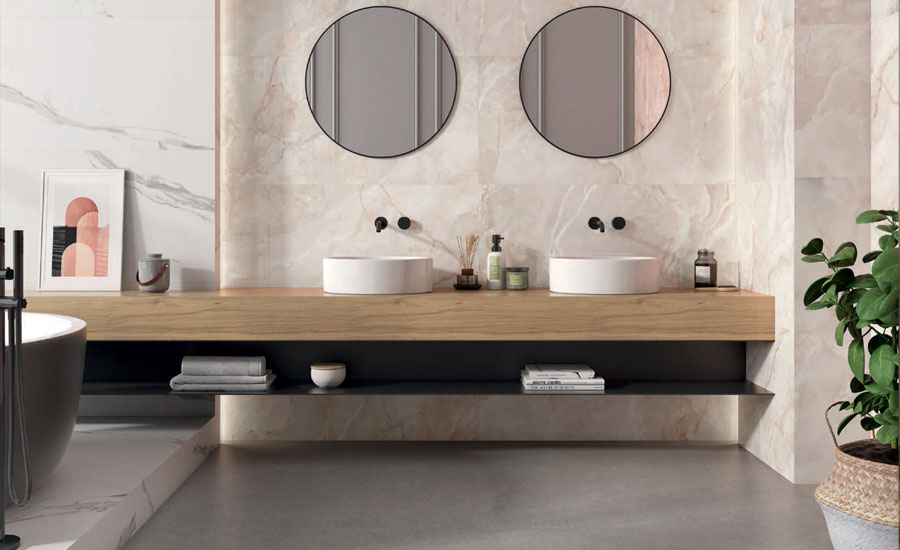
Best Tile Finishes and Textures for Bathroom Floors
Tiles can come in various finishes and textures, affecting the appearance and safety of your bathroom floor.
Matte Finish
Matte tiles have a soft, natural look and are slip-resistant. They are an ideal option for a bathroom where you can easily slip and fall due to accumulated moisture.
Water stains and smudges are not as visible on them as they are on glossy tiles.
Glossy Finish
Glossy tiles have a shiny, reflective surface that brightens up small bathrooms. However, they can become slippery when wet, increasing the risk of falls and injuries unless treated with an anti-slip coating.
Textured Tiles
Textured tiles resemble various materials such as stone or wood. Their embossed or rough surface offers better grip than glossy tiles and reduces the risk of slipping.
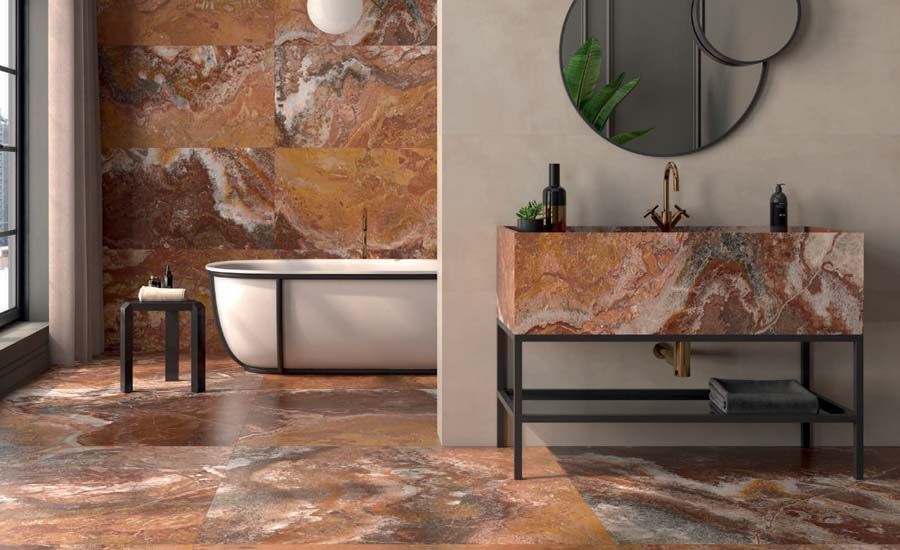
How To Choose the Best Tiles for a Bathroom Floor
Choosing the right bathroom floor tiles means balancing appearance and practicality so that you and your loved ones feel comfortable and safe.
- Prioritize slip resistance: Choose textured or matte tiles that provide better traction and prevent slipping on wet bathroom floors.
- Choose water-resistant materials: Porcelain, ceramic, and vinyl tiles have low water absorption, reducing the risk of moisture damage, stains, and mold growth.
- Think of durability: Go for porcelain, ceramic, or stone tiles that withstand daily wear and tear under busy foot traffic.
- Consider maintenance: Ceramic, porcelain, or sealed natural stone tiles require little effort to look attractive for years to come. Glossy tiles may need frequent wiping to look their best. Matte and textured tiles hide stains better.
- Consider bathroom size: large, light-colored tiles will make a small bathroom look bigger.
- Consider future-proof trends: Explore tiles with anti-bacterial coatings for enhanced hygiene, or eco-friendly options made from recycled materials. These types support sustainable living and align with modern design aesthetics.
Shop Bathroom Floor Tiles at Ceramista
Ceramista doesn’t just provide tiles. It delivers style, functionality, and innovation for your home or commercial space.
With our INSTANTILE interlocking system, bathroom floor installation is up to nine times faster than traditional methods, saving both time and labor costs without compromising on quality.
If a tile is damaged, simply replace it without disturbing the surrounding pieces, ensuring minimal disruption to your space.
Our eco-friendly ceramic tiles beautifully mimic materials like wood, stone, and steel, allowing you to achieve rustic, modern, or luxurious aesthetics.
Designed for modern living, Ceramista tiles are resistant to moisture, stains, and scratches, maintaining their attractive appearance with minimal effort. For detailed care, consult our maintenance guide.
Ceramista’s mission is to offer a cost-effective alternative to expensive stone and wood flooring, delivering the same luxury and performance at a fraction of the price.
Explore our collection today and transform your bathroom floor with Ceramista!
Best Tiles for a Bathroom Floor: FAQs
For more answers on bathroom floor tiles, check out the section below.
Which bathroom tiles are easiest to clean?
The easiest bathroom tiles to clean are the glossy tiles. Matte tiles hide dirt better but require occasional scrubbing.
What tile size should I choose for my bathroom floor?
Medium-sized tiles (12×12 inches or 12×24 inches) are an excellent option for most bathrooms. If you want to ensure better slip resistance, choose smaller tiles with more grout lines.
Can I use wood-effect tiles in my bathroom?
Yes, tiles that mimic wood will give your bathroom a warm and pleasant look while maintaining moisture resistance.
Can I use heated flooring under bathroom tiles?
Yes, you can install radiant heating systems under porcelain, ceramic, and stone tiles, adding warmth and comfort to your bathroom floor. This is a great solution if you live in colder climates.
